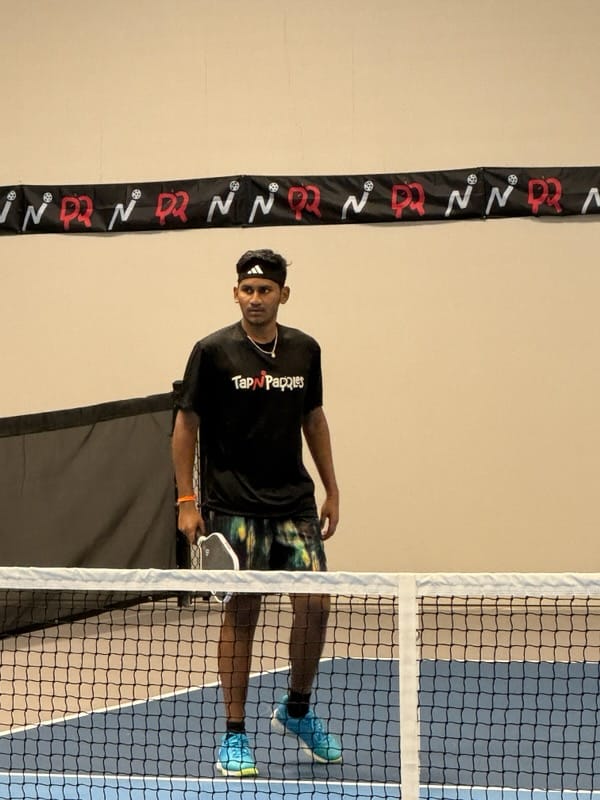How to Master the Pickleball Backhand Dink | Pro Tips for Better Control
How to Master the Pickleball Backhand Dink | Pro Tips for Better Control

One of the most important shots in pickleball, a rapidly growing sport that’s a cross between tennis, badminton and ping pong, is the dink. It may look simple, but the dink is an awesome weapon of controlling the pace, creating opportunities and inducing errors by your opposition. Of all the dink shots, the backhand dink may be the one that becomes the most uncomfortable for people, especially new players. (You see this grip used more and more by younger players today.) Mastering it can provide you with a huge advantage in rallies and keep you in control at the non-volley zone (kitchen line).
In this post, we are going to deconstruct what the backhand dink is and why it matters, as well as sharing step-by-step how to be successful with the backhand dink with the 2nd most important person in that house besides the person holding the camera (my wife Christine).
What Is a Backhand Dink?
The dink is a slow, feathery shot that is taken from around the kitchen line, and is meant to float just over the net and drop into the opponent’s kitchen. Here you want to ram the ball into the floor in the hope that your opponent can’t attack or muster enough power to tread on you.
A backhand dink is simply a dink that uses the backhand side of your paddle. This is when you place the paddle across your body with your knuckles facing the net (for RH players, usually on the left side of your body). As most players are naturally forehand-dominant the backhand dink can seem counter-intuitive to begin with. But once you nail it, it offers balance and flourish to your game.
Why the Backhand Dink Matters:
- Maintains Neutral Position
- With the backhand dink, you can stay in the driver’s seat during kitchen rallies. Without it, you will be made to run around shots which can make your positioning feel sloppy.
- Reduces Unforced Errors
- Wholly relying on forehand dinks becomes limited and predictable. Best solid backhand dink will allow your opponent to stand at the kitchen line and avoid errors.
- Sets Up Attacks
- A well-executed backhand dink can pull your opponent out of position allowing you or your partner a chance to attack.
- Builds Confidence in Rallies
- The backhand and forehand dinks are both import skills to develop so that you can stay cool and collected when there is a long exchange at the kitchen.
How To Hit The Perfect Backhand Dink (technical):
- Stance and Footwork
- Stand near the non-volley zone line, with knees slightly bent.
- Stand on the balls of your feet with your weight shifted a tiny bit forward, so that you’re ready to move side-to-side.
- Maintain your balance—don’t lean too far back or stay too straight up.
- Grip
- Hold with a continental grip (very like a hammer grip). This kind of grip enables you to differentiate between forehand and backhand dinks without having to move your hand.
- Paddle Position
- Do this drill with the body of the paddle held out in front of your body, not alongside your hip.
- Lens of the paddle should remain up (facing upwards).
Common Mistakes to Avoid:
- Hitting Too Hard
- It’s about control, not power, the dink. Whack too hard and the ball will pop up, allowing your opponent to smash.
- Standing Too Upright
- You won’t be able to reach the ball when your knees are straight, and you won’t have control over low balls.
- Using Too Much Wrist
- A flicky wrist is inconsistent. Instead, ensure that your wrist is firm and solid.
- Contacting the Ball Too Late
- Your shot loses its accuracy if the ball gets behind you. Make sure you hit the ball out in front of your body every time.
- Lack of Patience
- Too many rush to attack rather than maintaining patience in dink rallies. And remember, the backhand dink is a setup, not a finisher.
Pro Tips for a Great Backhand Dink:
- Stay Low and Compact
- Pro players stress that you should be standing low in general, and that good dinks come from this lower, kind of consistent pose. Staying low also enables you to cushion pace and redirect shots gently.
- Focus on Soft Hands
- Imagine that you’re cushioning the ball with your paddle. Once the player taps his or her opponent’s ball, the “soft touch” of the ball keeps the ball in the kitchen rather than bouncing high.
- Keep Your Eyes on the Ball
- It is an easy thing to say, but whenever young professionals do glance up too soon, many errors are made. Keep an eye on the ball until it reaches your paddle.
- Use Cross-Court Dinks
- Cross-court backhand dinks give you more leash because the net is lower and the two top edges of the court are farther apart. This increases consistency.
Drills to Practice Backhand Dinks:
- Wall Drill
- Stand 6–8 feet away from a wall and practise soft dinking against it but with your backhand only. This is how you build muscle memory and touch.”
- Cross-Court Kitchen Drill
- With a partner, work on cross-court backhand dinks. You want manageable consistency — how long you can keep it rolling.
- Target Practice
- Mark of cones in the opponent kitchen those of your opponents and see your accuracy of landing your dinks to those cones. This improves accuracy and placement.
- Two-Ball Drill
- Have a partner dinking to you (forehand/backhand alternating). This replicates what happens in a game and requires rapid adjustments.

Pingback: How to Volley in Pickleball Like a Pro: Techniques, Drills, and Net Strategies - Love2Pickleball